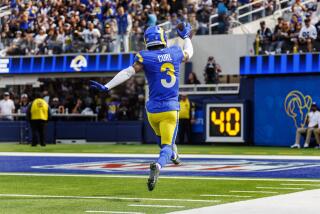Pro Football : A Conservative Raider Offense Wasn’t Enough
- Share via
Perhaps the most memorable play of the last game of the season for the Raiders was Marcus Allen’s 4 1/2-yard leap for a touchdown.
It surpassed even Allen’s previous best.
In recent years, he and other NFL backs have made the touchdown dive a routine art form. But for the others, the leap usually spans only a yard or so.
Allen can fly 3 or 4, or in this case 4 1/2 yards. He has become a most effective football long jumper.
The NFL’s ground-gaining champion this season, Allen deserves better than to be already out of the playoffs. So do most of his teammates.
It is popularly supposed that they were victimized last Sunday by their turnovers--three fumbles and three interceptions--but it wasn’t that, at all. They were the victims of their own pass offense, which couldn’t bail them out after the turnovers.
In their other big winning years, it usually did.
By a 27-20 score, the New England Patriots won the game with runs and passes of a kind that, significantly, aren’t even in the Raiders’ playbook.
That was most clearly illustrated in the first quarter, when each side got a break.
The Patriots got their chance first. After recovering a fumble at the Raider 21, they didn’t try to run it in, and when they called a pass, it wasn’t a conventional pass. It was a halfback pass.
One Patriot back, Craig James, rolled out and threw the ball to the other, Tony Collins.
That made it second-and-two, which, for the Raiders this year, was a running down. Later, the Patriots ran, too, on second-and-two, but in a scoreless game they attacked.
Their quarterback, Tony Eason, the NFL’s most underrated passer, rolled out and threw a running pass into the end zone to an open tight end.
That put the Raiders down, 7-0, after which they soon got their first break: a blocked punt by Greg Townsend that put them at the New England 16-yard line.
The old Raiders would have thrown the ball there. But as a proper running team, this team tried first to run, plunging straight ahead with Allen. He got about as much out of it, four yards, as anyone could with a plunge.
On second-and-six, when the Raiders decided they had to put the ball up, they tried a conventional, unremarkable pass to Todd Christensen. Marc Wilson threw it behind him. Christensen had his hands on the ball and could have held it, possibly, but didn’t.
Then, on third-and-six, everyone watching in America--presumably including the Patriots--was aware that the Raiders had to put it up again.
Eason had been asked to score in the comfort zone of second-and-two, but now, Wilson felt the pressure of third-and-six and fired the ball over Dokie Williams’ head in the end zone. The ball was so high it looked like a throwaway.
The running team settled for a field goal. And the Raiders were, so to speak, off and running. Before long, on an 11-yard pitch after a New England fumble, Allen had run them in front, 17-7.
After that, the Patriots resolutely drove to their only earned touchdown of the game, which James scored on a running play on third-and-goal from the Raider two. But it wasn’t a plunge. In fact, there was nothing routine about that run.
The Patriots lined up in shotgun formation, faking a pass, and sent James scurrying to his left behind the blocking of two All-Pro types, guard John Hannah and tackle Brian Holloway, whom James leaned on all day.
Surprised by the call, the Raiders didn’t have a linebacker in position to meet the play. There was only a safety there, Stacey Toran, and Hannah took care of him. James scored easily.
Thus the Patriots’ most damaging two hits of the first half, both delivered by James, a 1,000-yard ground gainer, were:
--A halfback pass from a running formation that set up a touchdown.
--A run from a passing formation, the shotgun, for a touchdown.
That day, neither play was in the Raider game plan. This is a club that doesn’t often use Allen for throwing the ball, although he is a former quarterback. Nor do the Raiders believe in the shotgun formation.
The Patriots do. There came a moment in the fourth quarter Sunday when the shotgun saved them.
They had moved ahead in the third quarter, 27-20, which turned out to be the final score. But normally in such circumstances, the Raiders have been a dangerous opponent. And when the Patriots appeared to be stalled at midfield, third-and-12, more than half of the last quarter remained.
What to do?
The shotgun, surely, but what kind of shotgun pass?
New England’s answer, when it came, was a shotgun run by James through the Raider line for 15 yards.
With that, the Patriots had bought the time that saved them.
This isn’t to say that the Raiders would have destroyed the Patriots with halfback passes and shotgun runs and passes. The Raiders have won without such plays, most of the time, for 20 years.
But in Sunday’s critical playoff game, their conservative new approach wasn’t enough. Allen can leap 4 1/2 yards but not 80. The Raider offense was simply and plainly insufficient that day. The organization should have found a way to open it up.
More to Read
Go beyond the scoreboard
Get the latest on L.A.'s teams in the daily Sports Report newsletter.
You may occasionally receive promotional content from the Los Angeles Times.










